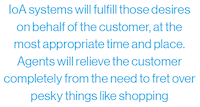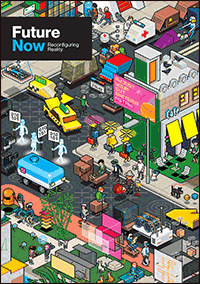Future Now
The IFTF Blog
Post Money
The basket of desires and how sellers can tap it
People don’t want products or services. They want their desires fulfilled. People will increasingly outsource this important job to software happiness agents devoted to discerning and fulfilling their every desire. Smart sellers will market directly to these agents as suppliers of happiness, which almost incidentally will come in the form of goods and services.
In this future, the Internet of Actions (IoA) will identify everything that makes an individual happy, using detected preferences, explicit and implicit communications, and social circle behavior. The data will be captured by sensors, data harvesting, and tracking, and run through algorithms that use collaborative filtering and deep learning to generate a private, happiness wish list, a secret accounting of everything that they want and aspire to attain, their “basket of desires.”
 This basket contains physical objects that they may want, such as an antique—or antique-looking—distressed brown leather messenger bag. It also contains experiences they would like to have—maybe a trip to Thailand to visit Phraya Nakhon Cave. It could even contain emotions they’d like to experience, real or virtual—(a woman contemplating motherhood, may wish to experience emotions such as the joy or fear of childbirth in VR before she decides to actually go through with it).
This basket contains physical objects that they may want, such as an antique—or antique-looking—distressed brown leather messenger bag. It also contains experiences they would like to have—maybe a trip to Thailand to visit Phraya Nakhon Cave. It could even contain emotions they’d like to experience, real or virtual—(a woman contemplating motherhood, may wish to experience emotions such as the joy or fear of childbirth in VR before she decides to actually go through with it).
Once created, these IoA systems will fulfill those desires on behalf of the customer, at the most appropriate time and place. Agents will relieve the customer completely from the need to fret over pesky things like shopping to buy things, managing money (financial literacy is waning anyway—would many be that sad if this went away?), and having a job (we are already seeing massive shifts from having a career to a gig, and finally, to a task-based, algorithmically-delivered economy). Working for money will be replaced by completing tasks to acquire items in the basket. Money, as a concept, will no longer be visible, or even useful, to the individual.
Let’s take a look under the hood. What happens when a happiness agent decides it is time to purchase an item in its owner’s basket of desires, and deliver it to them at the right time and place? It starts by throwing a request (deliver this item to this place at this time for this price) out into a global virtual marketplace, where the happiness agent and a multitude of provider agents negotiate toward a mutually beneficial result. Except in the case of an extremely rare item, the transaction is completed in nanoseconds. Hundreds of thousands of provider agents will bid to fulfill the customer’s desire. The customer won’t see or think about the cost or transaction details.

If you are a goods or services provider, how will your agent be able to get the sale, if the price is always the same, down to the nano-penny, from every other provider agent? If it knows the contents of the customer’s basket of desires, then it could offer the customer agent a “sweetener,” something else that the customer may want, that can be thrown in, from your network of partners, to clinch the deal. Here’s the scenario:
- Sophia is a gig worker who completes tasks for hundreds of companies, people, and agents. They don’t pay her in cash, but in a percentage of value toward a new object or experience in her basket. In her basket, among other things, she has a new VR rig, a Versace dress, and a trip to Italy. When her washing machine is about to run out of detergent, her basket asks her agent to get some. The agent asks retailers and brands to provide the detergent and negotiate an exchange of value. In an instant, they all provide the best possible price for the detergent, each of which are nano-pennies apart. The customer agent then throws out requests for sweeteners to the deal, to see if any of the retail or brand agents can enhance any of the upcoming experiences in Sophia’s basket to win the business. The provider agents search for a way to help Sophia realize a desire. One provider agent returns with an offer for a free fiber optic cable toward her new VR rig and another offers a free ice cream cone at Palazzo del Freddo Giovanni Fassi in Rome, for her trip. Sophia’s agent opts for the ice cream cone, and the deal is made. Later, when Sophia has a free moment to browse through her upcoming trip to Italy she discover the ice cream cone voucher. She can trade that cone’s value for something else, if she likes.
In this world, customer and seller agents quickly come to a static state on price, place, and time. There will almost always be a seller agent who will come to a profitless price, and if other seller agents match that price, they will not make the deal. In those cases, the seller agents can ask the customer agent about something else in the customer’s basket. It’s the equivalent of a salesperson asking, “Can I get you anything else to make this sale happen right now?” The customer agent may then reveal that the customer is planning a trip or something else from the basket. The seller agents then mine their partnerships for something to offer to the customer agent to tip the deal in their direction. They may come up with a plethora of deal sweeteners, and in the end, the customer agent will select the one that it feels its customer will appreciate the most, based on the priority of the items in the customer’s basket of desires.
In this future, sellers can no longer compete on price—they will need to maintain networks of collaborators who can provide that deal sweetener, at little to no cost to the seller, to make a sale for any kind of profit.
To win, sellers must look beyond price, service, and even product, and deliver happiness.
 FUTURE NOW—Reconfiguring Reality
FUTURE NOW—Reconfiguring Reality
This third volume of Future Now, IFTF's print magazine powered by our Future 50 Partnership, is a maker's guide to the Internet of Actions. Use this issue with its companion map and card game to anticipate possibilities, create opportunities, ward off challenges, and begin acting to reconfigure reality today.
About IFTF's Future 50 Partnership
Every successful strategy begins with an insight about the future and every organization needs the capacity to anticipate the future. The Future 50 is a side-by-side relationship with Institute for the Future: a partnership focused on strategic foresight on a ten-year time horizon. With 50 years of futures research in society, technology, health, the economy, and the environment, we have the perspectives, signals, and tools to make sense of the emerging future.
For More Information
For more information on IFTF's Future 50 Partnership and Tech Futures Lab, contact:
Sean Ness | sness@iftf.org | 650.233.9517



